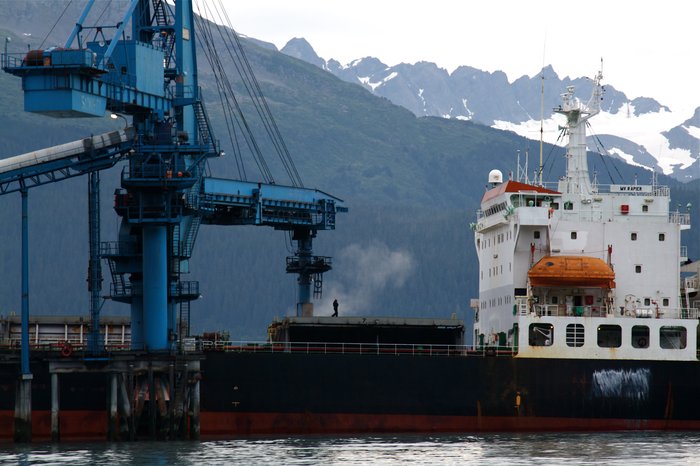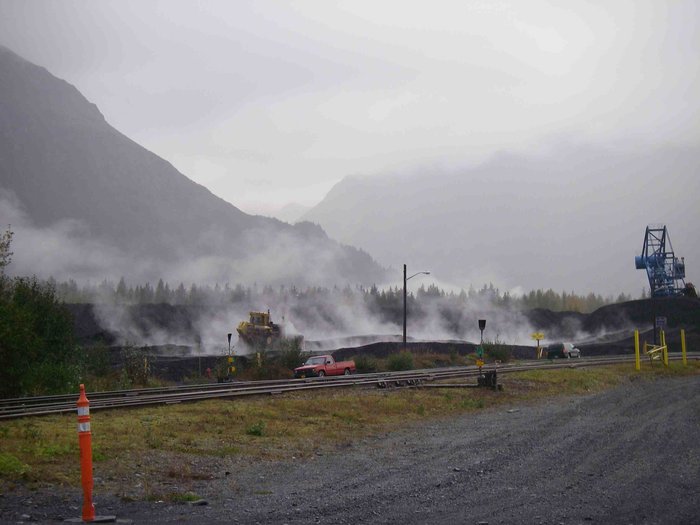

The Seward Coal Loading Facility, referred to as the Seward Coal Terminal, was built in 1984 to provide for the export of coal from Usibelli Coal Mine Inc. It ceased operation in 2016, and as of late 2019 there was no sign of it re-opening, but an expansion to the cruise ship port may indicate that the terminal will be decomissioned. The facility consists of a railroad spur, a variety of coal storage and handling and loading equipment, as well as a large dock. The Alaska Railroad purchased this facility in 2003 and has performed a variety of upgrades including an ongoing expansion of the coal storage areas in anticipation of increased coal exports from Alaska. However, a potential rail extension to Port MacKenzie could impact both this future traffic, and even the current exports out of Seward.
The biggest environmental concern surrounding the Coal Terminal has been the release of potentially hazardous coal dust from the facility. Seward experiences strong north winds draining dry interior air out into the Gulf of Alaska that can dry and then suspend the coal particles. If dust escapes at a similar rate to what has been calculated in the Environmental Impact Statement (EIS) for the loading facilities at the proposed Chuitna Coal strip mine, then around 500 tons of coal dust is released per year in Seward. The Coal Terminal facility possesses a dust collection system called a “baghouse” which could reduce particle release by an estimated 99%. However, this system has never been employed, is now defunct, and would cost approximately $1 million to replace. Another option for preventing coal dust release is to spray the coal with water, but this reduces the economic value of the coal by increasing the weight and moisture content
In addition to having problems with windblown dust, coal dust falls into the ocean from the conveyor as it passes from land to ship. In January 2010 a lawsuit was brought against the Alaska Railroad alleging that this dust violates the Clean Water Act. This suit was settled in 2015 with a commitment to make improvements and a $10,000 contribution to watershed conservation.
Coal dust became a prominent issue in Spring 2007 when a ship was loaded during high winds and large clouds of coal dust were released in the process. This dust exceeded air quality standards set by the Alaska Department of Environmental Conservation (DEC). Therefore the Alaska Railroad was issued with two citations regarding this incident. Since then the Alaska Railroad has spent $150,000 implementing new control measures for containing the dust, but still had dust release problems during high winds in January 2010. In June 2010, the DEC fined the Railroad $212,900 and the facility will be required to implment a variety of monitoring and mitagation procedures, as well as to pay the DEC for all costs associated with the ongoing investigation and enforcement. A multi-party lawsuit against the railroad is also proceeding through the courts and in January 2011 appeared set to go to trial. In July, an independant study was released showing high levels of coal-related polution in the air around Seward. In August 2014, a court ruled that the discharge into the bay was illegal.

Large coal stockpiles also carry the risk of spontaneous combustion causing coal fires deep within the piles. In order to avoid this, the coal must be regularly rotated to prevent the fires from spreading. “Hotspots” of smoldering coal embers can be regularly observed in the Seward stockpiles and can delay the loading of coal ships.
Similar concerns about coal dust and coal fires have been raised relating to proposed stockpiles of coal at the Chuitna Coal strip mine near Beluga.
Further Reading
Created: Jan. 19, 2018